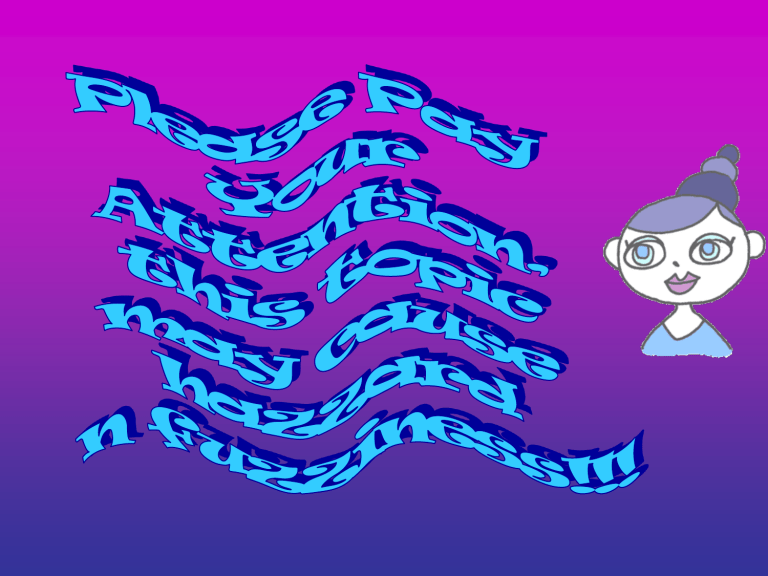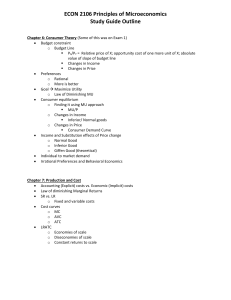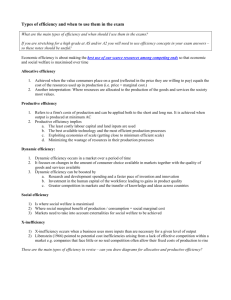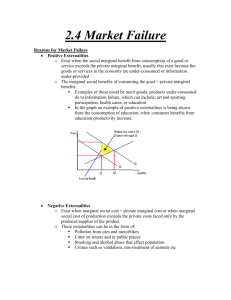
2010 Asiyah Kassim 2 The Role of Government Mixed Economy Market Failure Public Goods Externalities 1. To be able to explain the role of government especially in the effort to achieve relative health of economy 2. To explain the attributes of Mixed Economy 3. To discuss the various forms of market failure which require government interventions 4. To analyze the characteristics of public goods and the constraints of providing it 5. To understand the existence and the influences of externalities in public financial management. THE SCENARIO OF GOVERNMENT FINANCE ACTIVITY Public Finance The field of economics that studies government activities and the alternative means of financing government expenditures. Government Organizations formed to exercise authority over the actions of people who live together in a society and to provide and finance essential services. The Role of Government 1. Maintaining political and economic stability in the country 2. Protect the public interest at large 3. Encourage a stable economic growth 4. Reducing market failure The government action to achieve relative health of economy 1. Implement balance budget 2. Reform tax structure towards more equitable tax policy 3. Control inflation and unemployment rate at the minimum level 4. Generate better investment climate and infrastructure 5. Maintain foreign exchange rate THE SCENARIO OF GOVERNMENT FINANCE ACTIVITY Mixed Economy •A condition in which government supplies a considerable amount of goods and services and Regulates private economic activity. •In such economy, government expenditure typically amount to between one-quarter and one-half of GDP. •Taxes absorb at least one-quarter of national income. •Government usually regulate private economic activities and use taxes and subsidies to affect incentives to use resources Circular Flow in Mixed Economy In a mixed economy, government participates in markets as a buyer of goods and services. •Government purchase inputs from households and acquire ownership rights of such productive resources as land and capital. •Government use these inputs to provide goods and services that are not sold to household and business firms but are made available through ‘nonmarket rationing’. •Nonmarket rationing = Government goods and services are not made available to persons according to their willingness to pay and their use is not rationed by prices. Circular Flow in Mixed Economy •Government also purchase outputs of business firms such as paper, cars, bricks, and guns. •To pay for them, government requires businesses and household to make various payments such as taxes, charges and fees. •Government uses the productive resources it acquires to produce goods and services including national defense, roads, schooling, police etc. •Summary of the attributes -Cooperative role between public and private sector -Liberalization of economy - Encouraging productivity Market Failure Definition: Markets do not efficiently organize production or allocate goods and services to consumers. Or Situations where market forces do not serve the perceived public interest. Closely related with public goods and externalities Market Failure • Definition: • Where the market mechanism fails to allocate resources efficiently – Social Efficiency – Allocative Efficiency – Technical Efficiency – Productive Efficiency Market Failure Social Efficiency = where external costs and benefits are accounted for Allocative Efficiency = where society produces goods and services at minimum cost that are wanted by consumers Technical Efficiency = production of goods and services using the minimum amount of resources Productive Efficiency = production of goods and services at lowest factor cost Market Failure Allocative efficiency: Also referred to as Pareto Efficient Allocation – resources cannot be readjusted to make one consumer better off without making another worse off – zero opportunity cost! The Existence of Market Failure 1.Exercise of Monopoly Power in Market -when markets are dominated by only a few firms or by a single firm, the potential exists for the exercise of monopoly power -Firms exercising monopoly power can add to their profits by adjusting prices to the point at which marginal revenue equals their marginal private costs without fear of new entrants into the market. Market Power: Existence of oligopolies Collusion – conspiracy in the market Price fixing Abnormal profits Barriers to entry The Existence of Market Failure 2.Effects of Market Transaction on Third Parties Other Than Buyers and Sellers -when market transactions result in damaging or beneficial on third parties who do not participate in the decision, the result will be inefficiency. E.g. exhaust fumes from cars, trucks, factories, heating systems, power plants decrease air quality and impair public health External Costs and Benefits External or social costs The cost of an economic decision to a third party External benefits The benefits to a third party as a result of a decision by another party 3. Lack of a Market for a Good with a Marginal Social Benefit that Exceeds its. / Private sector failure in producing goods – PUBLIC GOODS -in cases where useful goods and services cannot be provided efficiently through markets because it is impossible or difficult to sell the good by unit. -Benefits of such goods can be shared only and these goods are public goods. E.g. National Defense 4. Incomplete Information -People often demand that government intervene in markets because of incomplete info about the risks of purchasing certain products or working in certain occupations. -E.g. We rely on government to test new drugs and to prevent hazardous products from being sold. And we also rely on government to established standards for safety in the workplace. 5. Economic Stabilization -Market imperfection, such as downwardly rigid wages, give rise to excessive unemployment in response to decreases in aggregate demand -Budget Constraints 6. Goods/Services are differentiated -Branding -Designer labels - they cost three times as much but are they three times the quality? -Technology – lack of understanding of the impact -Labelling and product information 7. Imperfect Knowledge: •Consumers do not have adequate technical knowledge •Advertising can mislead or mis-inform •Producers unaware of all opportunities •Producers cannot accurately measure productivity •Decisions often based on past experience rather than future knowledge 8. Inequality: •Poverty – absolute and relative •Distribution of factor ownership •Distribution of income •Wealth distribution •Discrimination •Housing Government Functions to Overcome Market Failure 1. To prevent monopoly control over price, government typically monitor markets to ensure that barriers to entry do not encourage the exercise of monopoly power. E.g. regulate the pricing policies of monopoly producers for electric power, natural gas and water. 2. Government engage in monetary and fiscal policies in an effort to stabilize the economy to correct for these market failures to ensure full employment -Monetary policy – determine the investment spending and consumer spending - Fiscal policy – changing the overall level of government taxing and spending 3. Governments also seek to avoid excessive and erratic inflation that can erode purchasing power and can impair the functioning of financial markets. Public Goods Definition: Goods with benefits that cannot be withheld from those who do not pay and are shared by large groups of consumers. The 4 major characteristics of public good 1. Government provision through tax – provided by government using the fund collected from various taxes 2. Non-exclusion – Unfeasible to price units of a public good = it is too costly to develop a means of excluding those who refuse to pay from enjoying the benefits of a given quantity of a public good. -E.g. it is unfeasible to exclude those who refuse to pay for a cleaner air from enjoying the benefits of a given amount of air quality improvement. Public Goods 3. Non-rival in consumption – a given quantity of a public good can be enjoyed by more than one consumer without decreasing the amounts enjoyed by rival consumers. -E.g. television and radio transmission & national defense. If rival = private goods. -Large external benefits relative to cost – socially desirable but not profitable to supply! 4. No direct user charge – no direct payment or fees imposed except for certain provision The present method of providing public goods 1. Free of charge to all the users 2. The cost completely borne by the government 3. Free rider and non-exclusive use The constraints of providing public goods 1. Unlimited demand and limited supply 2. Short of fund 3. Higher Cost 4. Political influence 5. Free-rider problem Other alternative ways 1. Pricing of public goods 2. Enforcing proper rules and regulations of consuming the goods Who is a Free Rider? A free rider is a person who seeks to enjoy the benefits of a public good without contributing anything to the cost of financing the amount made available. The free rider problem stems from the incentive people have to enjoy the external benefits financed by others, with no cost to themselves. Externalities Definition: Externalities is cost and benefits of market transaction not reflected in prices •When an externality prevails, a third party (other than buyers or sellers of an item) is affected by its production or consumption. •The benefits or costs of the third party (either household or a business) are not considered by either buyers or sellers of an item whose production or use results in an externality •It can be divided into 2:- Negative and Positive Externalities •Example of externalities : pollution How and Why Externalities… How Externalities occur? When one person’s actions affect another person’s well-being and the relevant costs and benefits are not reflected in market. Why need to address externalities? • Government will have to spend more as marginal costs exceed the marginal benefits (in a case of negative externalities). • Facilitate benefit forecast as (in a case of positive externalities) it can help to reduce the potential spending. Negative Externalities • also called external costs • the price of a good or service does not reflect the full marginal social cost of resources allocated to its production • it means: costs to third parties other than the buyers or the sellers of an item not reflected in the market price particularly in a case like damage by industrial pollutants • E.g. In the production of paper, each unit of output results in cost to parties other than the buyers or the sellers of the product. • Neither the buyers or sellers of the good consider these costs to third parties. • External Costs • Decision makers do not take into account the cost imposed on society and others as a result of their decision – e.g. pollution, traffic congestion, environmental degradation, depletion of the ozone layer, misuse of alcohol, tobacco, antisocial behaviour, drug abuse, poor housing Negative Externalities ( cont’) • A negative externality might be associated with paper production because of damages done by pollutants emitted into streams and rivers. • Pollutants decrease the benefit obtained by other users of streams, rivers or lakes such as commercial fishers, recreational user like boating etc. Positive Externalities • Prices do not fully equal the marginal social benefit of a good or service. • It means: benefits to third parties other than the buyers or the sellers of service/goods not reflected in prices • Note that, buyers or the sellers of goods that when sold, result in positive externalities do not consider the fact that each unit produced provides benefits to others. •E.g. purchase of smoke alarm / fire proofing, prevent from the spread of fire Positive Externalities •E.g. inoculation against a disease, in which those who are vaccinated benefit themselves of course, by reducing the probability that they will contract a contagious disease. • But they also provide benefits to those who do not receive inoculations by reducing the number of persons who will become host of the disease. Thus reduce the probability of outbreaks of disease. • In general, when a positive externality exists, marginal private benefit will fall short of marginal social benefit at each level of annual output. • External benefits – – by products of production and decision making that raise the welfare of a third party – e.g. education and training, public transport, health education and preventative medicine, refuse collection, investment in housing maintenance, law and order Internalizing of externalities (Balancing or neutralizing the condition) Occurs: •When the marginal private benefit or cost of goods and services are adjusted so that the users considers the actual marginal social benefit or cost of their decision. •In the case of a negative externality, the marginal external cost is added to marginal private cost for internalization •For positive externality, the marginal external benefit is added to marginal private benefit to internalize the externality •Internalizing an externality results in changes in prices to reflect full marginal social cost or benefit of a good How to internalize the externalities? 1. Corrective tax = designed to adjust the marginal private cost of a good or service , the tax must equal the marginal external cost per unit of output to achieve the objective (imposed counteractive or remedial taxes) In effect, a corrective tax is exactly like a charge fro emitting wastes. It is designed to internalize a negative externality by making sellers of the product pay a fee equal to the marginal external costs per unit of output sold. 2. Corrective subsidies = as a mean of internalizing the positive externalities – payment made by government to either buyers or sellers of a good so that the price paid by consumers is reduced for e.g. the provision of certain government services at levels below the marginal cost of such service. How to internalize the externalities? (Cont’) 3. Rules and regulations – to balance the cost n benefits 4. Government Monopoly – total power of a particular condition 5. Cost to government – on unavoidable situation or externalities 6. Effect public – to have the awareness on the cost and benefits of the market transaction and to be aware of government’s functions in internalizing the externalities. Economy Efficiency •Efficiency is a normative criterion for evaluating the effects of resources use on the well-being of individuals. •The efficiency criterion is satisfied when resources are used over any given period of time in such a way as to make it impossible to increase the well-being of any one person without reducing the well-being of any other person. •Simply state: it means producing a desired result with a minimum of effort or expense. •Economic efficiency as a major factor to provide good n services. 1. To avoid wastage in cost of providing the goods 2. Limited resources 3. Higher demand 4. Competition with private sector •One of the types of efficiency is Allocative efficiency. •It is achieved when the value consumers place on a good or service (reflected in the price they are willing to pay) equals the costs of the resources used in production. •Condition required is that price = marginal cost •When this condition is satisfied, total economic welfare is maximized. Economic Welfare & Subsidies •Whenever one talks about economic welfare, the concept of income subsidies and support will come into the picture. •Subsidy = a monetary grant given by a government to lower the price faced by producer or consumers of a good generally because it is considered to be in the public interest. •Income Subsidies & Support = monetary or incentives / assistance support ( either direct or indirect) as welfare aids to the appropriate groups. The impacts on economic welfare 1. Increase income 2. Future financial security 3. Reduced the financial burden 4. Less dependency on individual support






